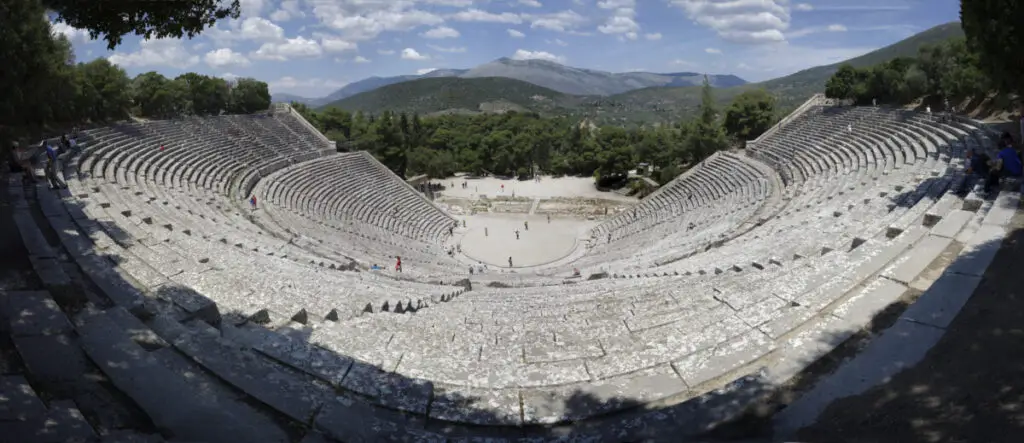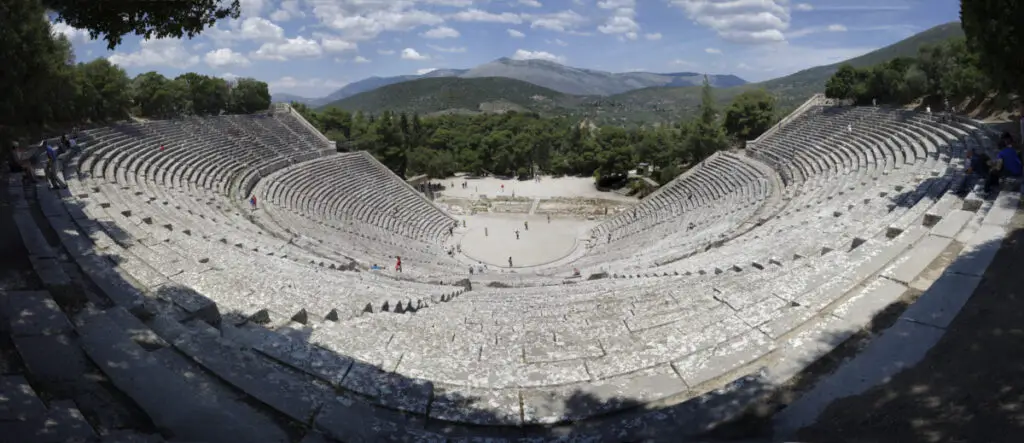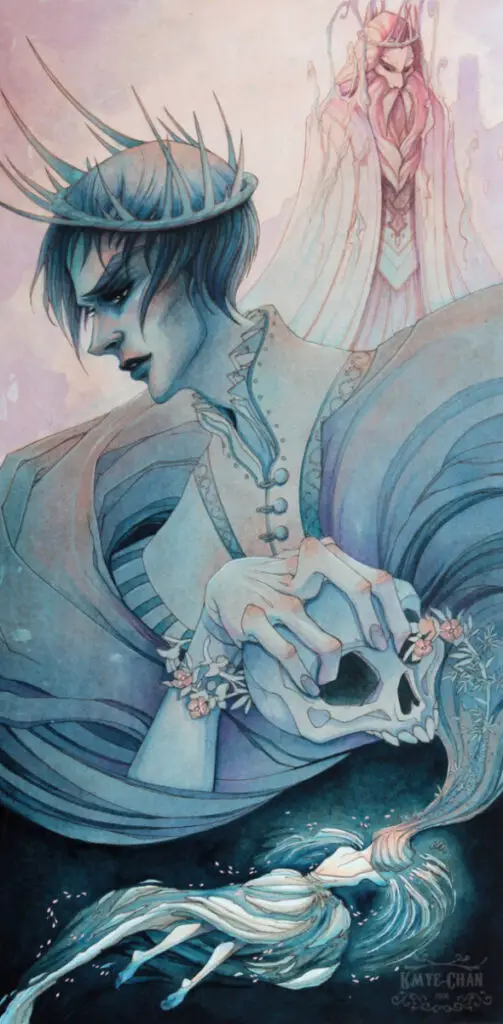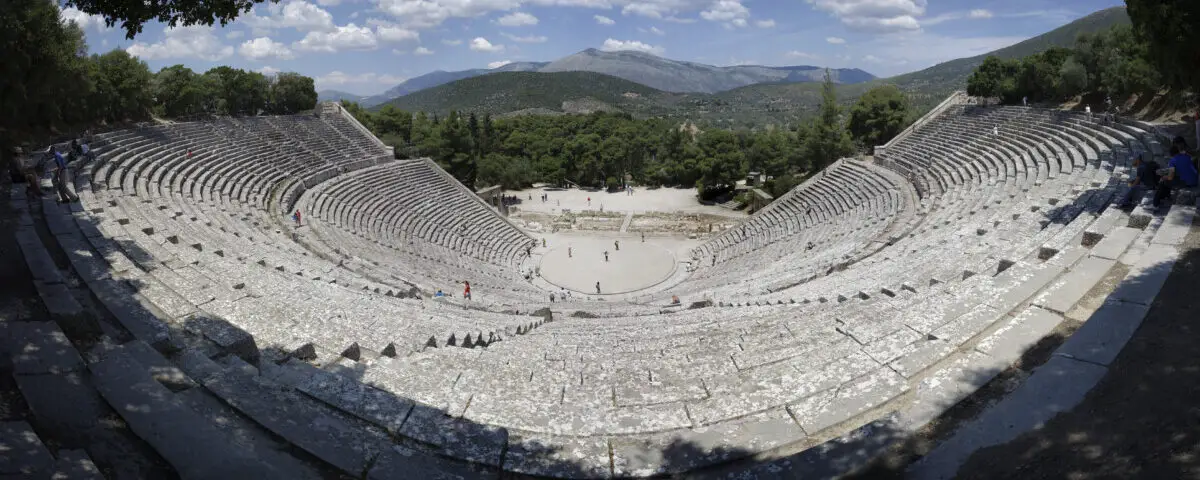Drama has been an integral part of human history for thousands of years. It entertains, educates, and reflects on society. From ancient Greek tragedies to modern-day plays, drama in history has evolved and adapted to different cultures and time periods.
Understanding the history of drama gives us an insight into the human experience and the evolution of storytelling. We can trace the history of drama back to the earliest civilisations. The ancient Greeks are a prime example of a culture that used drama to honour its gods and explore the human condition.
They performed drama, often associated with religious festivals, in the open-air theatres of ancient Greece. The plays explored themes of fate, morality, and the relationship between humans and the gods.
Drama in history has evolved and adapted to cultures and time periods. Ancient Greek and Roman drama to drama in the Middle Ages and the Renaissance, added unique elements to the art form. Many influential dramatic authors such as William Shakespeare and Tennessee Williams have left their mark on the history of drama. They shaped the art form into what it is today.

- Key Takeaways
- Drama has been a part of human history for thousands of years, providing entertainment, education, and a reflection of society.
- We can trace the history of drama back to ancient civilisations. The ancient Greeks used drama to honour the gods and explore the human condition.
- From ancient Greece to modern-day plays, drama in history has evolved and adapted to cultures and time periods. Influential authors William Shakespeare and Tennessee Williams shaped the art form into what it is today.
The Origins of Drama in History
The earliest known playwrights hail from ancient Greece.
Greek Drama
Drama in Greece has been an integral part of Greek culture for thousands of years. Its origins are found in ancient Greece, where they used drama as a form of art and ritual.
Because drama was so important to them, they held competitions in honour of Dionysus – the god of wine and fertility. They were known as the Dionysia. And they held competitions in Athens and other cities in Greece during spring and winter festivals.
Thespis
Thespis of Icaria (6th century BCE) is traditionally believed to be the first theatre actor. And he is considered to be the inventor of tragic drama. The chorus narrated the plays before Thespis. But Thespis is said to have introduced the use of individual actors who engaged with the chorus and thus differentiated characters from the narrators.
His innovative approach paved the way for the development of drama as a separate art form. And because he was a pioneer in drama, we often refer to actors as Thespians. However, due to a lack of records, it should be noted there is still debate over the exact nature of his contributions .
According to Aristotle in – Poetics, Thespis was the first person to win an award for tragic drama at the City Dionysia. The Athenian theatre festival was held around 534 BC. But there are sparse details of his works, and none of his plays have survived.
Tragedians
Ancient Greek plays performed in open-air theatres built on hillsides were attended by thousands of people. The audience sat on tiered stone steps, looking down on the flat stage in front of the seating area. The actors wore masks and elaborate costumes, which helped to identify the characters and their emotions.
Greek playwrights Aeschylus, Sophocles, and Euripides are considered the greatest tragedians of ancient Greece. Their plays dealt with:
- universal themes of love,
- justice, and
- the man’s conflict with the gods.
Aeschylus (c. 525 – c. 455 BC)
Aeschylus is often considered the father of tragedy. He is the earliest Greek tragedian whose plays survived and is credited with introducing multiple characters and the concept of the trilogy. Some of his most well-known works are:
- Prometheus Bound,
- The Oresteia, and
- The Persians.
Before authors wrote plays, many cultures had oral traditions that involved storytelling and performance. However, specific playwrights from those traditions are not identifiable.
Among surviving early plays, Aeschylus has seven tragedies written in the 5th century BCE. By including more than one actor he made the chorus smaller at 12 people. Aeschylus created the structure for drama aesthetics that influenced plays for 2,000 years and more.
Sophocles
A famous playwright, Sophocles wrote more than 120 plays. But it is disappointing only seven have survived. Among them is Oedipus Rex, his most well-known.
Sophocles’ Oedipus Rex has never been surpassed for the raw and terrible power with which its hero struggles to answer the eternal question, “Who am I?” The play, a story of a king who acting entirely in ignorance kills his father and marries his mother, unfolds with shattering power; we are helplessly carried along with Oedipus towards the final, horrific truth.
Amazon.com
This vibrant new translation invites its readers to lose themselves in the unfolding of this tragic tale as suspenseful as a detective mystery, yet with an outcome long ago determined by Fate. –
Euripides
The third famous classical Athens tragedian was Euripides, who wrote about 90 plays, of which 19 have survived.
His most famous tragedies, which reinvent Greek myths and probe the darker side of human nature, include Medea, The Bacchae, Hippolytus, Alcestis and The Trojan Women…
Southern Adventist University
Political and Social Commentary
The Greek theatre was not only a place for entertainment but also a place for political and social commentary. Plays often dealt with current issues and events, and were used as a means to criticise the government and society.
Old Comedy
The Greeks also developed a form of comedy known as Old Comedy, which was characterised by political satire and crude humor.
The most famous Old Comedy playwright was Aristophanes, whose plays such as The Clouds and Lysistrata are still performed today. Aristophanes was a famous playwright of the Greek comedy. He wrote more than 40 plays, and his works were known for their political and social satire.
Takeaway

Drama was an essential part of Greek culture and entertainment. The plays were performed during festivals, and they dealt with current issues and events. The three famous ancient Greek tragedians were Aeschylus, Sophocles, and Euripides, while Aristophanes was a famous playwright of Old Comedy.
Roman Drama
Roman drama has a rich history that spans centuries. There are three major phases of development.
- The ancient period (pre-240 BCE) – when native Italian drama dominated the Roman stage. It included:
- Atellan farces,
- Phlyaces, and
- Fescennine verses.
- The literary drama period (240 BCE – ca. 100 BCE) – The Romans took classical and post-classical Greek plays which they adapted.
- Then Roman drama proper (ca. 100 BCE – 476 CE), saw the emergence of fabula praetexta (historical plays) and fabula crepidata (plays in Greek style with Roman characters).
Roman Theatre
Roman theatre was an important part of Roman culture. The theatre was usually located in the centre of a town and was used for a variety of events. They included:
- plays,
- gladiatorial games, and
- public speeches.
The audiences were diverse and included people from all walks of life. They were often rowdy and would shout out comments during the performance. Because they loved the spectacular, many producers included elaborate sets and costumes.
So, the theatre was a place where people congregated to enjoy being entertained.
Roman Playwrights
Ancient Rome had several playwrights, especially during its literary golden age. However, only a fraction of their works survived. Here are some of the most notable:
Plautus (c. 254–184 BC)
Known for his comedies, many of which were adapted from Greek originals. Some of Plautus’ most well-known works were Menaechmi, Pseudolus, and Amphitryon. Plautus was one of the most famous Roman playwrights whose comedies were popular with audiences.
His plays were characterised by his use of farce, puns, and physical humour. And the actors who performed them wore masks to help identify the characters they were playing. Actors were usually male, and they often played multiple roles in a single play.
Terence (c. 195/185–159 BC)
Another major comedic playwright, Terence adapted many of his plays from Greek sources. His works include The Eunuch, Phormio, and The Brothers.
Seneca (c. 4 BC – AD 65)
The most famous Roman tragedian. Seneca’s works were adaptations of Greek tragedies and are known for their intense emotional and psychological drama. They include Thyestes, Phaedra, and Medea.
Quintus Ennius (c. 239–169 BC)
While more famous for his epic poetry, Ennius also wrote tragedies, though only fragments of his works survive.
Marcus Pacuvius (c. 220–130 BC) and Lucius Accius (c. 170–c. 86 BC)
Both Pacuvius and Accius were well-known tragic playwrights, but little of their works survive today.
Takeaway

There were others and many plays during the Roman period, but the vast majority have been lost to history. The works of Plautus and Terence had a significant influence on later European drama, especially during the Renaissance. Drama was an important part of Roman culture, when many famous drama playwrights spanned centuries. The actors, audience, and theatre were all important parts of Roman drama.
Drama in the Middle Ages
During the Middle Ages, drama was an important part of religious life. The Church used plays to teach Bible stories to the illiterate population. These plays were performed in Latin and were often accompanied by music and dance. The earliest known plays called liturgical dramas were performed in churches.
Theatre as we know it today did not exist in the Middle Ages. Instead, plays were performed in public spaces such as town squares or in front of churches. These spaces were often transformed into makeshift stages using simple props and scenery.
The audiences were diverse and included the rich and less privileged. And as time went on, plays evolved into two distinct types: Mystery and Morality.
Mystery
Mysteries were based on stories from the Bible and were performed by guilds in public spaces. They often included elaborate sets and costumes and were performed over several days. And they were often performed in public spaces, which meant that anyone could attend.
Morality
Morality plays were allegorical and focused on the struggle between good and evil. They were performed by traveling troupes and were popular with both religious and secular audiences. And they were often played in private homes or inns and were attended by a more select audience.
Actors
In medieval drama actors were often amateurs who were members of guilds. These guilds were responsible for organising and performing mystery plays. Actors were not paid for their performances and often had to provide their own costumes. Despite this, many people were eager to participate in plays to gain favour with the Church.
Takeaway

Drama played a key role in religious life during the Middle Ages. Mystery and morality plays were the two most popular types of plays and were performed by amateur actors for diverse audiences. While theatre as we know it today did not exist, plays paved the way for the development of modern theatre.
Renaissance and Drama
The Renaissance period is known for its significant contribution to the development of drama. At the time, playwrights and actors began to experiment with new forms of drama, creating plays that were more complex and realistic than ever before. The Renaissance also saw the emergence of some of the greatest playwrights in history, including, arguably the greatest, William Shakespeare.
Character Evolution
One of the most significant changes that occurred during the Renaissance was the move towards more realistic and complex characters. Playwrights began to create characters with more depth and complexity, allowing audiences to connect with them on a deeper level. This change was reflected in the emergence of new acting techniques, with actors striving to create more realistic portrayals of the characters.
Shakespeare is the most famous playwright of the Renaissance period. He wrote plays that explored a wide range of themes, from love and betrayal to power and politics. His plays were notable for their complex characters and intricate plots, which made them popular with audiences of the time. And he is as important and popular today.
New Theatrical Forms
The Renaissance period also saw the emergence of new theatrical forms, such as the opera and the masque. These forms combined drama with music, dance, and spectacle, creating a more immersive and entertaining experience for audiences. The masque was popular with the aristocracy and often featured elaborate costumes, sets, and special effects.
Takeaway

The Renaissance period was a time of meaningful change and development for drama. Playwrights and actors experimented with new forms and techniques, creating plays that were more complex and realistic than ever before. The legacy of this period can still be seen in the plays and performances of today.
Influential Figures in Drama
Throughout history, there have been many influential figures in the world of drama. These individuals have made significant contributions to the art form, shaping it into what it is today. Here are a few of the most notable dramatic figures in history:
William Shakespeare (1564-1616)

William Shakespeare is one of the greatest playwrights and arguably the most famous in history. He is known for writing some of the most famous plays and sonnets in the English language. All have become published books, adapted for the big screen, and many, such as Hamlet and Romeo and Juliet, are now household names. Shakespeare’s works continue to be performed and studied to this day, and his influence on the world of drama is without precedent.
It’s difficult to determine exactly how many Shakespeare books have been sold. That is primarily because he lived over 400 years ago, during a time when there were no standardised records for book sales. Additionally, his works were originally sold as individual play quarto pamphlets, not as books in the modern sense.
Since his death in 1616, his works have been continuously published, adapted, and studied worldwide, making him one of the most widely read authors in history. The First Folio, which is the first collected edition of Shakespeare’s plays, was published in 1623 and has been followed by countless editions and compilations.
Considering the span of time and the global appreciation for Shakespeare’s works, it’s safe to say that many millions of copies have been sold. This figure would encompass a wide range of editions and formats, including individual plays, collected works, adaptations, educational editions, e-books, etc.
However, sales numbers and exact figures are not available for earlier periods. Today’s sales of Shakespeare’s works continue to be substantial, thanks to their enduring popularity and their status as staples in academic curricula worldwide.
Anton Chekhov (1860-1904)
Anton Chekhov the Russian playwright and short-story writer was best known for his plays The Seagull, Uncle Vanya, and The Cherry Orchard. Chekhov’s works are known for their complex characters and themes, and his influence on modern drama cannot be overstated.
Tennessee Williams (1911-1983)
Tennessee Williams was an American playwright who is best known for his plays A Streetcar Named Desire and Cat on a Hot Tin Roof. Williams’ works explore themes of desire, passion, and human relationships, and his influence on American drama is significant.
August Wilson (1945-2005)
August Wilson was an American playwright who is best known for Pittsburgh Cycle, a series of ten plays that explore the African American experience throughout the 20th century. Wilson’s works are known for their powerful storytelling and vivid characters, and his influence on American drama is undeniable.
Takeaway

These are just a few of the many influential dramatic figures in history. Their contributions have helped shape drama, and their works continue to be studied and performed worldwide.
Drama Across Cultures
Drama, in its many forms, has been a central part of human culture for millennia. Every society, from the most isolated tribes to the most cosmopolitan cities, has its own traditions of storytelling, performance, and theatre.
Europe
- Greek Drama: Ancient Greece is recognised as the birthplace of Western drama. There were two main types of plays: tragedies and comedies. Leading playwrights wrote plays that are still studied and performed today.
- Commedia dell’arte, Italy: Originating in the 16th century, this form of theatre is characterised by masked actors and improvised performances based on sketches or scenarios. It is considered a precursor to modern comedy.
- Elizabethan Drama, England: The Elizabethan era in England produced some of the most revered playwrights in the English language.
Asia
Drama has a rich history in Asia dating back to ancient times. The major features of Asian drama can be seen in the three great classical sources of India, China, and Japan. Indian drama is known for its use of music and dance, while Japanese drama often incorporates elements of traditional Japanese culture.
- Indian Sanskrit Drama: Rooted in the ancient scriptures and religious traditions of Hinduism, Sanskrit drama goes back more than 2000 years. The playwright Kalidasa wrote seminal works, such as Shakuntala, that are celebrated for having intricate plots and lyricism.
- Chinese Opera: There are many forms which include Peking Opera and Kunqu. Chinese Opera is known for its stylised performances, combining music, vocal performance, mime, dance, and acrobatics.
- Noh and Kabuki, Japan: Noh is a form of traditional Japanese musical drama. The plays are based on tales from traditional literature with a supernatural being transformed into a human shape. Kabuki is known for its colourful costumes, makeup, and elaborate performances.
- Shadow Puppetry: Predominant in Southeast Asian countries like Indonesia and Malaysia, shadow puppetry involves the manipulation of puppets made of animal hide against a lit backdrop.
Africa
- Yoruba Opera, Nigeria: Yoruba blends music, drama, and dance, typically featuring Yoruba folklore and mythological subjects.
The Americas
Indigenous tribes in the Americas have rich traditions of storytelling and performance, often rooted in spiritual and communal rituals.
In the USA, drama has been an important part of the entertainment industry. It has given rise to some of the most famous actors and actresses in the world. Drama has also been used as a tool for social commentary, with plays addressing prominent issues such as racism, gender inequality, and political corruption.
Takeaway

Drama has been a powerful tool for storytelling and entertainment across cultures. It has brought people together to share stories and experiences and has played a significant role in shaping the way we think about the world around us.
Modern Drama
The advent of realism in the 19th century saw drama tackle contemporary social issues and personal stories. For example, Anton Chekhov, Henrik Ibsen, and playwrights Tennessee Williams, Arthur Miller, and August Wilson offered perspectives on the human condition.
Apart from forms and traditions there are universal themes that drama across cultures addresses –
- love,
- conflict,
- identity,
- morality, and
- the nature of existence.
Drama not only reflects the values and concerns of a society but also has the power to shape and change them. It has also played a significant role in the development of other art forms. For example, many plays have been adapted into movies, and the theatre has influenced the development of literature and poetry.
The Art of Drama
Drama is a performance art that involves actors, costumes, scripts, audio, and visual art. Drama is a way of telling stories through performance and has been of cultural part of society throughout history.
Actors
The Actors, or performers, are the heart of drama. They bring the characters and thereby the story to life. The performance of the actors is crucial to the success of any form of drama, be it theatre, movies, video, or podcast. They must be able to interpret and convey the emotions and feelings of the characters they portray.
Costumes
Costumes reflect the period of drama, and they help to create the atmosphere and setting of the story. The costumes must be appropriate for the time and the personality of the characters. They must also be comfortable enough for the actors to move freely and perform their roles effectively.
Script
The backbone of any drama, the script or dialogue the actors have to learn and interpret, must be well-written and engaging. It should be easy enough for the actors to understand, so they can captivate the audience and draw them into the drama.
Performance
The final piece of the puzzle, performance, is the culmination of all the elements of drama. A superior performance is one that is engaging, emotional, and memorable. The actors must be capable of bringing the story to life and of capturing the attention of the audience.
Takeaway

Drama is an art form that involves actors, costumes, scripts, and performance. Each element must be carefully crafted to create a successful drama. When done well, drama can be a powerful and emotional experience for both the actors and the audience.
The Impact of Drama on Society
Drama has the power to reflect and shape society’s beliefs, values, and attitudes towards any human issue. Through drama, society can explore and challenge power structures, including race and gender. It is therefore a powerful tool which can impact social change and raise awareness.
As a platform, marginalised voices can be heard through drama and authors can help society to confront biases and prejudices. For example, plays such as A Raisin in the Sun and The Colour Purple challenge the dominant narrative of white supremacy and give voice to the experiences of African Americans.
Drama has the power to shape societal norms and expectations around gender. Plays like A Doll’s House and The Trojan Women have challenged traditional gender roles and have given voice to women’s experiences in male-dominated societies.
Moreover, drama can bring people together and foster a sense of community. The shared experience of watching a play can create a sense of empathy and understanding between people from different walks of life.
Takeaway

Drama in history has had a profound impact on society. It has the power to challenge power structures, shape societal norms, and bring people together. As such, it remains an essential tool for social change and a means of exploring and understanding the complexities of human experience.
Frequently Asked Questions
What are some examples of historical dramas?
Historical dramas are dramatic texts based on historical material. Some examples of historical dramas include William Shakespeare’s Julius Caesar and Arthur Miller’s The Crucible. Another example is Hamilton, a musical that tells the story of Alexander Hamilton, a founding father of the United States.
How has drama evolved throughout history?
Drama has evolved throughout history, with different periods and cultures developing their own unique styles and forms. Ancient Greek drama included the use of masks and a chorus, while Elizabethan drama in England was characterised by the works of William Shakespeare and the use of blank verse. In modern times, drama evolves with new forms such as musical theatre and experimental theatre emerging.
What is the significance of drama in literature?
Drama is significant in literature because it allows authors to explore complex themes and ideas using dialogue and action. Drama can also be used to critique society and to provide social commentary. In addition, drama can be a powerful tool for education and can be used to teach history, culture, and language.
What are some notable historical events that have been depicted in drama?
Many historical events have been depicted in drama, including the assassination of Julius Caesar, the Salem Witch Trials, and the American Revolution. Other notable examples include the French Revolution, World War II, and the Civil Rights Movement. Drama can provide a unique perspective on historical events and can help to bring history back to life for audiences.
Why not Join Us
If you enjoyed this article, we would like to offer you two gifts – our Starter Pack of 4 James King’s books and our Weekly Digest, which you can receive by email.

